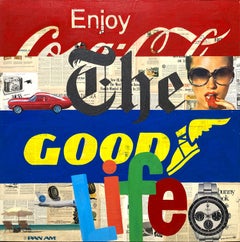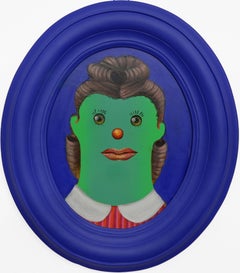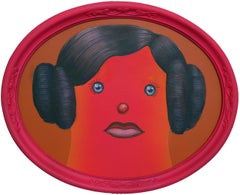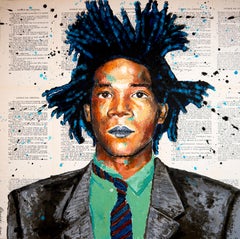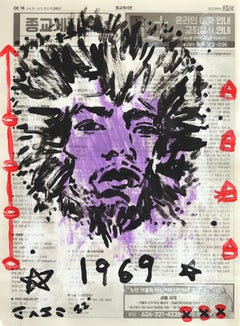Pop Art Portrait Paintings
Perhaps one of the most influential contemporary art movements, Pop art emerged in the 1950s. In stark contrast to traditional artistic practice, its practitioners drew on imagery from popular culture — comic books, advertising, product packaging and other commercial media — to create original Pop art paintings, prints and sculptures that celebrated ordinary life in the most literal way.
ORIGINS OF POP ART
- Started in Britain in the 1950s, flourished in 1960s-era America
- “This is Tomorrow,” at London's Whitechapel Gallery in 1956, was reportedly the first Pop art exhibition
- A reaction to postwar mass consumerism
- Transitioning away from Abstract Expressionism
- Informed by neo-Dada and artists such as Jasper Johns and Robert Rauschenberg; influenced postmodernism and Photorealism
CHARACTERISTICS OF POP ART
- Bold imagery
- Bright, vivid colors
- Straightforward concepts
- Engagement with popular culture
- Incorporation of everyday objects from advertisements, cartoons, comic books and other popular mass media
POP ARTISTS TO KNOW
- Richard Hamilton
- Andy Warhol
- Marta Minujín
- Claes Oldenburg
- Eduardo Paolozzi
- Rosalyn Drexler
- James Rosenquist
- Peter Blake
- Roy Lichtenstein
ORIGINAL POP ART ON 1STDIBS
The Pop art movement started in the United Kingdom as a reaction, both positive and critical, to the period’s consumerism. Its goal was to put popular culture on the same level as so-called high culture.
Richard Hamilton’s 1956 collage Just what is it that makes today’s homes so different, so appealing? is widely believed to have kickstarted this unconventional new style.
Pop art works are distinguished by their bold imagery, bright colors and seemingly commonplace subject matter. Practitioners sought to challenge the status quo, breaking with the perceived elitism of the previously dominant Abstract Expressionism and making statements about current events. Other key characteristics of Pop art include appropriation of imagery and techniques from popular and commercial culture; use of different media and formats; repetition in imagery and iconography; incorporation of mundane objects from advertisements, cartoons and other popular media; hard edges; and ironic and witty treatment of subject matter.
Although British artists launched the movement, they were soon overshadowed by their American counterparts. Pop art is perhaps most closely identified with American Pop artist Andy Warhol, whose clever appropriation of motifs and images helped to transform the artistic style into a lifestyle. Most of the best-known American artists associated with Pop art started in commercial art (Warhol made whimsical drawings as a hobby during his early years as a commercial illustrator), a background that helped them in merging high and popular culture.
Roy Lichtenstein was another prominent Pop artist that was active in the United States. Much like Warhol, Lichtenstein drew his subjects from print media, particularly comic strips, producing paintings and sculptures characterized by primary colors, bold outlines and halftone dots, elements appropriated from commercial printing. Recontextualizing a lowbrow image by importing it into a fine-art context was a trademark of his style. Neo-Pop artists like Jeff Koons and Takashi Murakami further blurred the line between art and popular culture.
Pop art rose to prominence largely through the work of a handful of men creating works that were unemotional and distanced — in other words, stereotypically masculine. However, there were many important female Pop artists, such as Rosalyn Drexler, whose significant contributions to the movement are recognized today. Best known for her work as a playwright and novelist, Drexler also created paintings and collages embodying Pop art themes and stylistic features.
Read more about the history of Pop art and the style’s famous artists, and browse the collection of original Pop art paintings, prints, photography and other works for sale on 1stDibs.
2010s Pop Art Portrait Paintings
Canvas, Mixed Media, Acrylic, Newsprint
2010s Pop Art Portrait Paintings
Canvas, Acrylic
2010s Pop Art Portrait Paintings
Wood, Acrylic, Plywood, Spray Paint
2010s Pop Art Portrait Paintings
Wood, Spray Paint, Acrylic, Plywood
2010s Pop Art Portrait Paintings
Gesso, Paper, Glue, Mixed Media, Oil, Spray Paint, Acrylic, Stretcher Bars
21st Century and Contemporary Pop Art Portrait Paintings
Mixed Media, Acrylic, Newsprint
2010s Pop Art Portrait Paintings
Canvas, Acrylic
Artist Comments
Boldy colored and stylized figures fill the scene. Their expressions exude anticipation as if waiting for a band to start or a train to arrive. The blue backg...
21st Century and Contemporary Pop Art Portrait Paintings
Acrylic
2010s Pop Art Portrait Paintings
Enamel
2010s Pop Art Portrait Paintings
Wood, Spray Paint, Acrylic
2010s Pop Art Portrait Paintings
Canvas, Acrylic
2010s Pop Art Portrait Paintings
Mixed Media, Acrylic, Newsprint, Canvas
2010s Pop Art Portrait Paintings
Canvas, Mixed Media, Spray Paint, Acrylic
2010s Pop Art Portrait Paintings
Canvas, Oil
2010s Pop Art Portrait Paintings
Mixed Media, Pigment, Archival Pigment
2010s Pop Art Portrait Paintings
Mixed Media, Acrylic, Screen
Artist Comments
A family enjoys a cheerful picnic, radiating warmth, happiness, and connection. Vibrant hues, especially golden sunlight, and a bright blue sky, enhance the s...
21st Century and Contemporary Pop Art Portrait Paintings
Oil
2010s Pop Art Portrait Paintings
Paint, Ink, Mixed Media, Oil, Spray Paint, Acrylic, Felt Pen, Pencil, St...
2010s Pop Art Portrait Paintings
Metal
2010s Pop Art Portrait Paintings
Epoxy Resin, Mixed Media, Acrylic, Wood Panel, Newsprint
2010s Pop Art Portrait Paintings
Canvas, Paint, Acrylic
2010s Pop Art Portrait Paintings
Canvas, Acrylic
21st Century and Contemporary Pop Art Portrait Paintings
Latex, Oil, Panel
2010s Pop Art Portrait Paintings
Acrylic, Oil Pastel, Archival Paper
21st Century and Contemporary Pop Art Portrait Paintings
Enamel
2010s Pop Art Portrait Paintings
Spray Paint, Acrylic, Canvas
2010s Pop Art Portrait Paintings
Plywood, Spray Paint, Acrylic, Resin
2010s Pop Art Portrait Paintings
Acrylic, Board, Oil
2010s Pop Art Portrait Paintings
Canvas, Paint, Acrylic
2010s Pop Art Portrait Paintings
Canvas, Glue, Mixed Media, Oil, Spray Paint, Acrylic
1980s Pop Art Portrait Paintings
Canvas, Acrylic
2010s Pop Art Portrait Paintings
Enamel
1980s Pop Art Portrait Paintings
Screen, Canvas, Acrylic
20th Century Pop Art Portrait Paintings
Charcoal, Illustration Board, Paper
2010s Pop Art Portrait Paintings
Wood, Spray Paint, Acrylic
21st Century and Contemporary Pop Art Portrait Paintings
Enamel
Early 2000s Pop Art Portrait Paintings
Linen, Acrylic
21st Century and Contemporary Pop Art Portrait Paintings
Oil, Canvas, Screen
Early 2000s Pop Art Portrait Paintings
Linen, Acrylic
2010s Pop Art Portrait Paintings
Canvas, Oil
2010s Pop Art Portrait Paintings
Canvas, Acrylic
2010s Pop Art Portrait Paintings
Spray Paint, Acrylic
1990s Pop Art Portrait Paintings
Canvas, Plastic, Acrylic
2010s Pop Art Portrait Paintings
Enamel
1990s Pop Art Portrait Paintings
Paper, Illustration Board, Cardboard, Carbon Pencil
1970s Pop Art Portrait Paintings
Canvas, Oil
2010s Pop Art Portrait Paintings
Canvas, Acrylic
Artist Comments
Three stylized figures stand against a vibrant orange background. Their animated features and exaggerated use of color infuse the scene with personality and whimsy. Artist John McCabe created this artwork as a promotional poster for the band Good at Rockets' performance at the Orange County Fair in 2024.
About the Artist
Artist John McCabe produces graphic illustrations that take a progressive spin on pop art. He typically takes influence from his music to create vibrant caricatures of people, places, and things significant to the industry. Growing up, one of the highlights for John when buying music is the artwork on the packages. Inspired by that, he created art for his first EP, and every subsequent release includes artwork for each single, plus a front and back cover for the record. "The pieces are normally tied or related to the lyrics of a particular song," shares John. "In the case where I have made a series structured around music, a unique narrative unfolds within each." As imaginative as he is, John usually paints from the island surface of his kitchen or the dining room table. His music studio also doubles as a work area where he does pre-sketches. John has had several profiles from VoyageLA, Shoutout LA, and Queen City Arts and Sounds. His record label has featured his works along with his eclectic music releases.
Words that describe this painting: band, stripes, polka dot, men, trio, small, group, friends, musicians, people, pop, fashion, acrylic painting, orange
Green Room...
21st Century and Contemporary Pop Art Portrait Paintings
Acrylic
2010s Pop Art Portrait Paintings
Canvas, Resin, Acrylic, Giclée
21st Century and Contemporary Pop Art Portrait Paintings
Charcoal, Ink, Mixed Media, Acrylic, Wood Panel
2010s Pop Art Portrait Paintings
Wood, Spray Paint, Acrylic
2010s Pop Art Portrait Paintings
Canvas, Mixed Media, Spray Paint, Acrylic
2010s Pop Art Portrait Paintings
Canvas, Oil
2010s Pop Art Portrait Paintings
Gesso, Canvas, Linen, Varnish, Acrylic
2010s Pop Art Portrait Paintings
Wood, Spray Paint, Acrylic
2010s Pop Art Portrait Paintings
Canvas, Spray Paint, Acrylic
21st Century and Contemporary Pop Art Portrait Paintings
Oil, Canvas
2010s Pop Art Portrait Paintings
Canvas, Acrylic
